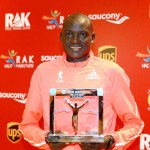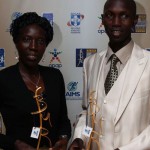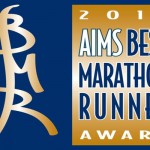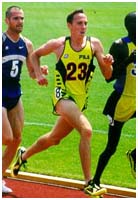Organisers of road races around the world gathered in Marathon (Greece) on Saturday for the 3rd Marathon Symposium of the Association of International Marathons and Road Races (AIMS). On the day before the 27th Athens Classic Marathon, which featured around 12,000 runners (including running events at shorter distances), the topic was ,Charity Programs and Marathon Movements’.
The Athens Classic Marathon led from Marathon to Athens on Sunday. It was there where the modern story of the classic race began back at the Olympics in 1896. The idea of the marathon origins from the legend of Pheidippidis, who is said to have run the distance from the battlefield near Marathon to Athens to announce the Greek victory against the Persians in 490 BC. After doing so he collapsed and died.
“There could not be a better place than here, at the Marathon Tomb, to renew our commitment to running, based on fairplay, friendship and peace,” said Paco Borao, the Vice President of AIMS during his speech at a ceremony at the tomb. The event was witnessed by the President of Greek, Karlos Papoulias. “As the queen of the Olympics marathon wants to carry on its image of ethics, solidarity and peace represented by this sport,” said Paco Borao. “AIMS is an association devoted to promote running, working with the IAAF, all around the world and expanding knowledge and experience between members for the well-being of our favourite sport. Millions of people practice the easiest, healthiest, cheapest sport in life: running.”
AIMS and the Athens Classic Marathon are also already preparing a unique jubilee event in 2010: It will then be 2,500 years ago since the marathon was born. “In 2010 the Athens Classic Marathon will be an outstanding race. For every marathon runner it will be something special to participate in it. There could not be a more significant marathon jubilee. The race next year will be a similar highlight as the 100th Boston Marathon in 1996 or the Berlin Marathon after the fall of the wall in 1990,” explained Horst Milde, who is an AIMS Board Member and the Chairman of the Symposium.
Before the afternoon session of the AIMS Symposium the marathon flame was carried by a pupils’ torch relay from Marathon Tomb to the starting point of the Athens Classic Marathon. Here another flame was lighted and two small ones in laterns handed to representatives of two international marathons: The race in Mumbai on 17th January and the Vienna City Marathon on 18th April 2010 will feature a marathon flame from Marathon.
Among the key speakers at the Symposium was John Caine. He is the Special Projects Director of Nova International in Britain, which runs the Great Run races. Their most prestigious event is the Great North Run, the world’s biggest half marathon starting in Newcastle. John Caine outlined in detail the success story of charity running. In 2008 the Great Run series had a total of 170,000 runners and generated an amount of 28 million British Pounds for charity. This was only the sum collected from those official charities with which the organisers cooperate. Caine expects the annual total to go beyond 30 million this year.
As John Caine recommended organisers should first determine a certain percentage of their field size that they would like to reserve for charity runners. Then they have to contact those charities, which they would like to become official partners. After an agreement the organisers of the Great North Run then pass on vouchers to their charities. For each voucher a runner will receive a starting number for the race and the entrants are then treated by the organisation as every other participant. “This procedure works best in races, which are sold out so that runners can not enter any more through us,” explained John Caine. His race offers a certain amount of places at the normal entry rate to the charities. Runners who decide to run for one of these charities will get the entry for free from one of the official charities provided they collect a certain amount of donations. The sums the charities normally ask for could be five times as high as the entry fee, which the charties payed to the organisers. So there is a good profit for a good cause.
Runners who run for a charity have a personal motivation to do so. As John Caine explained this could have a medical or political background and it could also be an animal welfare or social issue. Charity runners approach family, friends, colleagues or other people they know, asking them to sort of sponsor their race by donating a certain amount to the charity. It could be something like a Euro for each kilometre or mile.
Besides substantial donations there is more with which to attract charities. At the Great North Run a charity partner gets a link and video clips on the event web site, they get space at the runners’ expo, special checkpoints at the course, a hospitalilty area for their runners in the finish area pluse adverts in the programme. Individual stories of charity runners are also passed on to the media.
As Mark Dickinson, the race director of the Beirut Marathon, explained a race will receive additional publicity when the charity partner uses its contacts to search for charity runners. In Beirut organisers also make sure that during the TV live coverage a charity phone number is shown where viewers can donate instantly.
In Britain meanwhile the biggest race organiser is neither the Great Run nor the London Marathon but a charity organisation. As John Caine reports there is a series of 5 k races with a total of 750,000 runners. Course and time measurement don’t matter much in these races. While John Caine stresses that it is a great success for the charity he believes that all aspects – the event, the charity and the sport – should benefit from charity running.
“In many parts of the world charity running is not common. Even in central Europe there is very little charity running,” said Horst Milde. “This is why we at AIMS will continue to support the idea of charity running and encourage organisers to include it into their races. It is an important topic for the society.”
image by photorun



























Speak Your Mind